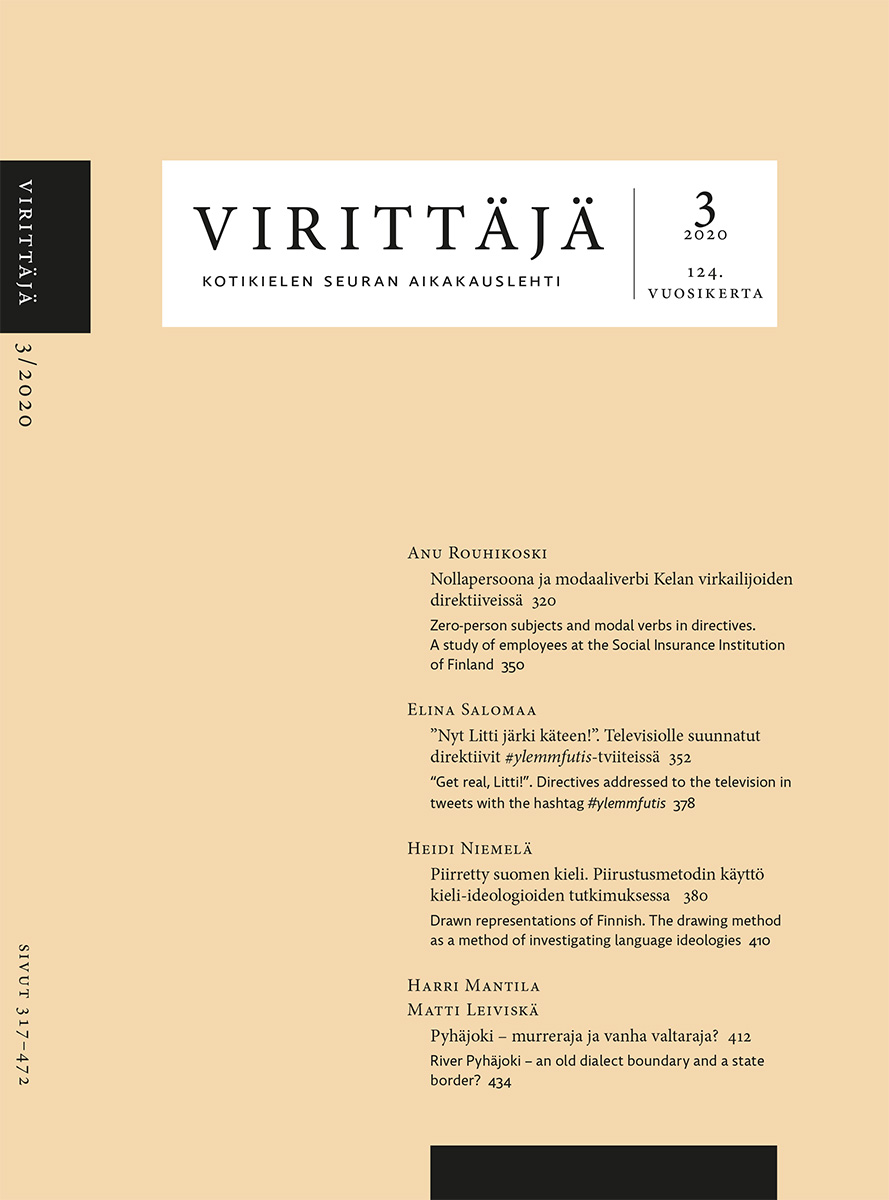Pyhäjoki – murreraja ja vanha valtaraja?
Abstrakti
Artikkelissa tarkastellaan keskipohjalaisten ja pohjoispohjalaisten eli Oulun seudun murteiden rajaa. Kettusen murrekartastosta on poimittu kahdeksan piirrettä, jotka erottavat näitä murteita toisistaan. Näitä piirteitä ovat esimerkiksi t:n heikon asteen vastineet ja yksikön 3. persoonan päätteet. Nämä samat piirteet ovat myös itä- ja länsimurteita erottavia piirteitä siten, että keskipohjalaiset variantit ovat läntisiä ja pohjoispohjalaiset itäisiä.
Analyysi pohjautuu pääosin Muoto-opin arkiston kokoelmiin. Murreanalyysin tulos on, että kaikki tähänastiset rajanvedot keski- ja pohjoispohjalaisten murteiden välillä ovat olleet liian pohjoisia. Murreraja on toki häilyvä, mutta pohjoispohjalaiset (ja itäiset) variantit ovat vallalla jo heti Pyhäjoella tai sen pohjoispuolella. Artikkelissa palataan myös siihen Kettusen esittämään argumenttiin, että puheena olevien murteiden raja on Pattijoessa, koska se on ollut Pähkinäsaaren rauhan (1323) rajalinja. Tässä Kettunen nojaa historiantutkija Jalmari Jaakkolan näkemykseen. Muissa tutkimuksissa rajaksi on tulkittu Pyhäjoki tai Petäjäisoja.
Murreanalyysi tukee vahvasti Pyhäjoen tulkintaa rajajoeksi, varsinkinkin kun historiantutkimuksessa Pyhäjoen voidaan todeta olleen itä- ja länsisuomalaisen asutuksen välinen intressiraja. Viimeaikaisen tutkimuksen mukaan samoille alueille sijoittuu myös geneettinen raja.
River Pyhäjoki – an old dialect boundary and a state border?
This article discusses the boundary between the Central and Northern Ostrobothnian (Oulu region) dialects. The focus is on eight dialectal features (taken from Kettunen’s classic dialect map) that separate these dialects. These features include the weak-grade equivalents of t and the endings of 3rd-person singular verb forms. These features are also deemed to separate the eastern and western dialects of Finnish so that the Central Ostrobothnian variants represent the western dialect type and the Northern Ostrobothnian variants represent the eastern type.
The present findings are based primarily on the materials of the Finnish Morphological Archive. The results suggest that all former borderlines between the Central and Northern Ostrobothnian dialects were drawn too far to the north. Naturally, the dialect boundary is rather fluid, but most of the Northern Ostrobothnian (and eastern) variants are already represented in the river valley around Pyhäjoki or in the parishes immediately to the north.
In addition, the article re-examines Kettunen’s definition of this dialect boundary. Kettunen claims that the boundary runs along the Pattijoki valley, and in his estimation this reflects the borderline of the Pähkinäsaari Treaty (1323), the first treaty between the Swedish Kingdom and Novgorod. Here he cites the views of historian Jalmari Jaakkola. Some historians have subsequently suggested that the borderline ran along either the Pyhäjoki or Petäjäisoja rivers.
Dialectological analysis strongly supports the interpretation of Pyhäjoki’s being the border, especially because historians have already proved that Pyhäjoki was once the northernmost border of the western Finnish settlement. According to recent research, it seems that Pyhäjoki represents a genetic border too.






